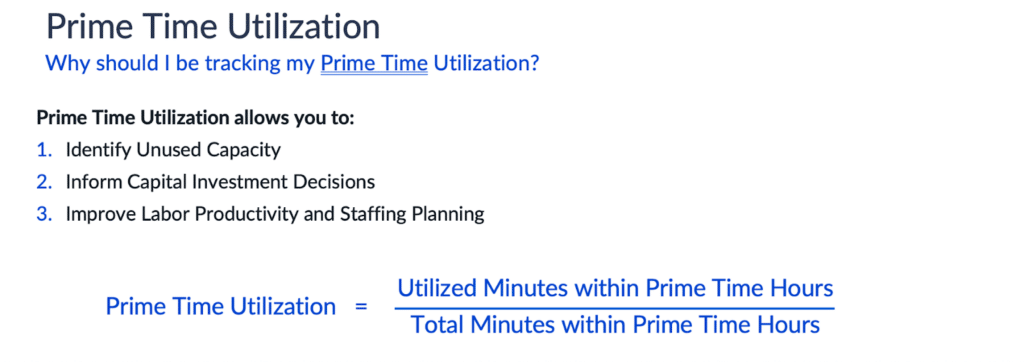Many operating rooms (ORs) rely on surgical block time utilization as a key operational metric, and they are not incorrect to do so. Block utilization is an important measure of the overall health of OR time distribution and allocation, and of operating room utilization as a whole.
Block time utilization is so broad, however, that it often only indicates that distribution problems exist. It does not direct OR leaders to the true causes of those problems or ways to solve them. The issues underlying low block utilization are also often deep rooted, so that by the time they become visible in block utilization scores, they are impossible to resolve in a timely or effective way.
Examining related operating room performance metrics that are more specific, immediate, and actionable will support the improvement of surgical block utilization. Prime time utilization, for instance, is a key precursor to overall OR utilization.
Calculating prime time OR utilization
Optimal OR utilization is not only driven by how fully surgeon blocks are used, but more accurately based on the total usage within the OR facility’s business hours, or “prime time.” This is when the department is staffed and resources are readily available to perform surgeries. Cases performed outside prime time often lead to even greater costs associated with staff overtime and increased inefficiencies. Particularly for the many surgical facilities facing staff shortages, fully utilizing prime time is crucial.

Simply calculated, operating room prime time utilization equates to the percentage of available minutes filled with case minutes during business hours. This simple metric avoids the complications and pitfalls that too often hinder other efficiency metrics.
For most hospitals and surgery centers, a significant portion of prime time hours are allocated through OR block scheduling on the assumption there is consistent demand from surgeons scheduling cases into the same time blocks week after week. The allocation of these times is typically initiated through a committee and often influenced by politics and seniority rather than actual surgeon volume or utilization.
Surgeons who do have block time, however, don’t always have the case demand to fill that time. Surgeons who do have that case volume often lack the access to backfill those open periods. Valuable operating room time goes unused as a result. This is reflected in low prime time utilization.
Visibility into factors that drive prime time OR utilization
Prime time utilization is a lagging indicator. Once it is low, there is no way to make up for the lost time. Additionally, without the right tools, OR performance reporting often takes weeks to compile and months or even quarters to act upon. In order to proactively improve utilization, managers and leaders need predictive and prescriptive analytics that are timely, accurate, accessible, and flexible enough to allow a deep dive to drill into specific challenges, root causes, and opportunities for improvement.
iQueue for Operating Rooms provides a single source of truth to deliver actionable data that surgeons and perioperative leaders can trust. Data is approximately real-time and includes rich drill downs, clear visualizations and prescriptive analytics, and capabilities to push key measures, weekly alerts, and personalized scorecards to surgeons and their offices. As a result, administrators are more confident, surgeons are more engaged, and the system of stakeholders, including surgical schedulers, is enabled to have more objective conversations around managing OR capacity.
Several leading healthcare systems, after adopting iQueue to facilitate the collection and exchange of OR time, have seen success in increasing prime time utilization. The Washington-based MultiCare, in the two years prior to the COVID pandemic, achieved a 12.4% increase in prime time utilization across 30 operating rooms. Baptist Health Jacksonville, excluding the three-month period most impacted by COVID limitations, improved the same measure by 8% in one year. Such results go beyond pure metrics and have a true impact on the lives of patients and staff.
Positive results from prime time utilization, for the OR and its patients
Solving for low prime time utilization benefits not only the operating room but also patients and the entire organization. When prime time is used to its full potential, patients can get their surgeries scheduled sooner, surgical offices have more predictable schedules with fewer add-ons or rescheduled cases, and facilities and staff avoid costly nighttime, after-hours cases. Hospital leaders can make more informed capital budgeting decisions around expanding OR facilities – including, in some cases, realizing costly expansions are not necessary at all.

To learn more about optimizing your own prime time utilization, view the webinar “Optimizing Prime Time Utilization”, or contact LeanTaaS to discuss further or request a demo.






